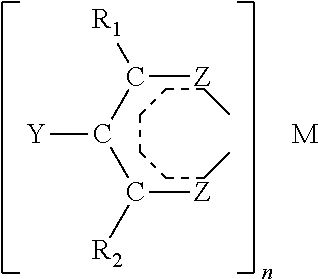Catalytic antioxidants
a technology of antioxidants and catalytic compounds, applied in the field of lubricating oil compositions, can solve the problems of poor lubrication, accumulation of particulate matter in lubricating oils, and accumulation of engine parts
- Summary
- Abstract
- Description
- Claims
- Application Information
AI Technical Summary
Benefits of technology
Problems solved by technology
Method used
Image
Examples
examples 1-3
[0169]In the examples, 1 through 3, a series of oils were formulated using a synthetic oil having a kinematic viscosity of 4 cSt at 100° C. and typical additive components as are shown in Table 1, except that the antioxidant additives used were those of the present invention.
[0170]The formulations were evaluated in a Thermo Oxidation Engine Oil Simulation Test (TEOST), as provided for by ASTM D7097, also referred to as TEOST [MHT4], herein incorporated by reference, to determine the mass of deposit formed under oxidative conditions. The results of the test are given in Table 2. The concentrations of the antioxidant compounds used are given in ppm by weight based on the total amount of lubricant base oil. As can be seen in Comparative Example 3, when a substituted diaryl o-phenylenediamine compound was used in combination with an ashless hindered phenol, but without a polymetal organometallic compound, the weight of the deposit was 26.3 mg. When 100 ppm of the polymetal organometalli...
examples 4-8
[0176]Decomposition of tert-butyl hydroperoxides (t-BHP) was carried out in a fully formulated synthetic oil having a kinematic viscosity of 4 cSt at 100° C. containing the typical additive components of Table 1, except that the only antioxidant additives used were those of the present invention.
[0177]Separate samples were prepared containing a 2 gram aliquot of oil and the concentrations of antioxidants listed in Table 3, respectively, using the same antioxidants, A, B and C, as those used in Examples 1-3. A sample was added to a 250 ml Erlenmeyer flask. To this was added 100 ml of acidified isopropanol (IPA) / toluene solvent (10% vol. glacial acetic acid, 65% vol. IPA and 25% vol. toluene). The mixture was stirred until the oil dissolved. Excess t-BHP in isooctanol was added to the mixture and stirred. To the resulting solution was added 10 ml of sodium iodide in IPA reagent, prepared fresh daily by refluxing 20 g NaI in 100 ml IPA. The resulting mixture was then refluxed to a temp...
examples 9-14
[0180]The same procedure used in Examples 1-3 was followed except that the oil used was a Group II mineral oil.
[0181]
TABLE 4TEOST[MHT-4]ABCDeposit,(ppm)(ppm)(ppm)(mg)Example 910010005002.9Example 10100100010004.6Example 11505005003.5Example 1250100010004.9Comparative0500500109.0Example 13Comparative1.4Example 14(Fully formulatedmineral oil)
[0182]As can be seen in Table 4, the compounds exhibit significant synergy when used in combination resulting in very low deposits in the oil comparable to the commercial antioxidant, as shown in Example 14, yet at lower concentrations. Although not demonstrated, it is believed that using compound A with compound B or compound A with compound C would also result in a synergistic effect albeit not as great as when all three compounds are used in combination.
[0183]The fully formulated oil used in Comparative Example 14 contained about 0.75 wt % of a commercially available antioxidant. The catalytic antioxidants of the present invention exhibited com...
PUM
| Property | Measurement | Unit |
|---|---|---|
| atomic numbers | aaaaa | aaaaa |
| atomic numbers | aaaaa | aaaaa |
| atomic numbers | aaaaa | aaaaa |
Abstract
Description
Claims
Application Information
 Login to View More
Login to View More - R&D
- Intellectual Property
- Life Sciences
- Materials
- Tech Scout
- Unparalleled Data Quality
- Higher Quality Content
- 60% Fewer Hallucinations
Browse by: Latest US Patents, China's latest patents, Technical Efficacy Thesaurus, Application Domain, Technology Topic, Popular Technical Reports.
© 2025 PatSnap. All rights reserved.Legal|Privacy policy|Modern Slavery Act Transparency Statement|Sitemap|About US| Contact US: help@patsnap.com



